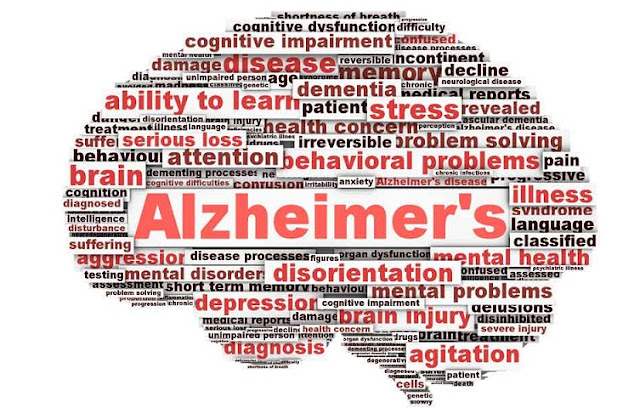Alzheimer's, Not Merely Attack The Brain
Nerve disease experts in Indonesia will meet at the National Congress VIII Neurologist who is scheduled to take place on 5-9 August 2015 in Makassar, South Sulawesi.
With regard to the national agenda was to introduce to the public the related Alzheimer's disease presented perspectives regarding this disease.
Alzheimer's Disease (AD) was first described by experts in Psychiatry and neuropatologi Germany film named Alois Alzheimer as a unique case "presenil dementia" found in the 51-year-old woman who suffered from "paranoid delusional disorder and memory", "progressive aphasia."
A similar case also rediscovered and published in 1996. From the patient's autopsy found the presence of brain tissue are shrinking and by staining found the existence of an idea known as senile plaques (NPs), which consists of a distrofik neurit (now known as the plaque neuritik), namely network found "core amyloid".
On coloring intraneural, brain cells of Alzheimer's sufferers to form the pattern of fibrilar "fibrillary tangles" (NFTs).
Researcher named Kraeplin later named this clinical pathology overview as "AD constellation", and in the mid-20th century, found only 100 similar cases in the medical literature.
The definition
Alzheimer's disease is a progressive neurodegenerative disorder characterized by loss of nerve cells progressively, particularly in the area of the hippocampus and kortex basal brain front, causing a decrease in the ability of storing short-term memory, naming and language proficiency, the ability of visuospasial and executive functions.
Currently, neurodegenerative diseases is considered to occur due to the distractions of merging and aggregation of proteins. Alzheimer's disease up to now is not simply a nuisance about the brain only.
The prevalence of Alzheimer's disease increased between 65-85 years, doubled on any increase in the age of 5 years.
Currently, Alzheimer's disease is known as a disease that most often attacks the age group 65-74 years, and the fourth-largest cause of death in the United States (u.s.) on the age group.
Population studies on various other countries shows the prevalence and incidence of profiles that are similar.
Hispatologi
Alzheimer's disease histoptologi marker is the accumulation of plaques containing extracellular amyloid neuritik à (AÃ), and "neurofibrillary tangles" which consist of hiperfosforilasi microtubules associated with the protein.
At the beginning of the disease also found a loss of neurons in the basal part of the brain that is front kolinergik and loss of activity "kolin asetiltransferase" on "cortex".
Currently, Alzheimer's disease in people with either familial or sporadic, amyloid precursor protein is processed into amyloid à à which accumulate and beragregasi on extracellular plaque. Amyloid à is toxic to cells and triggers the phosphorylation of tau led to further "intracellular tangles". This process is known as "amyloid cascade hypothesis".
Familial Alzheimer's disease clinical picture (FAD) and sporadic (SAD) is almost the same. However, FAD has "early onset", i.e. less than 65 years, so called "early onset of AD", about 5 percent of Alzheimer's cases.
While sporadic Alzheimer's is often called the "late onset AD" since about age more than 65 years, and is 90 percent of Alzheimer's cases in the clinic.
In the early stages, sufferers experience a decrease in short-term memory, language proficiency, visuospasial and executive functions. It could also happen to drop in memory immediately and long-term memory (because of the disorder often occurs on the inside of the lobe temporalis).
Decrease in episodic memory, as evidence of the earliest changes in glucose metabolism on the "prekuneus" and "psoterior" cingulata.
At a later stage, symptoms of psychological disorder form behaviors and neurobehaviour, depression, sleep disturbances, anxiety, psychosis (hallucinations and delusions). On the advanced stage patients can not get out of bed, incontinence occurs (pasein can't hold time would waste water), persistent vegetative and death.
Risk Factors
Risk factors of this disease that is knowledge that low, the presence of the disorder cerebrovascular disease, head injury, hypertension, increased homosistein, a diet high in fat.
Additional examination can be done in between, lab examination, a routine blood examination, blood chemistry, and special examination: serum (Amyloid Beta/AÃ 40), 42, AÃ homosistein, folate, CRP, ApoE4, brain fluid examination: routine, AÃ 42 levels decrease or increase in the levels of the protein.
Radiology examination of which a CT scan and MRI of the head, PETscan with FDG (fluorodeoxyglucose), PET scan with specific radioligand
Handling of Alzheimer's sufferers Pharmacology term nowadays, namely: Cytidine-choline as neuroselular protection and the synthesis of the neurotransmitter acetylcholine, fosfatidilserin (PS) for meperbaiki the structure of cell membranes, acetylcholinesterase inhibitor (AchEI), modulation of glutamate receptors (memantine) for regulating the transmission of glutamatergik dysfunction and thus preventing the death of neurons like Pharmacology term complementary therapies, antioxidants, hormones estrogen and anti-inflammatory with attention to side effects.
In addition, therapeutic Pharmacology term is also given on the neuropsikiatrik behavior and disruption experienced by sufferers.
The handling of future targeted at the reduction of the accumulation of amyloid deposition, reducing à NFT, preventing excessive tau phosphorylation, delivery of antibodies to produce antibodies against amyloid accumulation of endogenous Ã.

Belum ada tanggapan untuk "Alzheimer's, Not Merely Attack The Brain"
Post a Comment